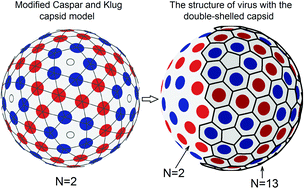Hidden symmetry of small spherical viruses and organization principles in “anomalous” and double-shelled capsid nanoassemblies
Abstract
We propose the principles of structural organization in spherical nanoassemblies with icosahedral symmetry constituted by asymmetric protein molecules. The approach modifies the paradigmatic geometrical Caspar and Klug (CK) model of icosahedral viral capsids and demonstrates the common origin of both the “anomalous” and conventional capsid structures. In contrast to all previous models of “anomalous” viral capsids the proposed modified model conserves the basic structural principles of the CK approach and reveals the common hidden symmetry underlying all small viral shells. We demonstrate the common genesis of the “anomalous” and conventional capsids and explain their structures in the same frame. The organization principles are derived from the group theory analysis of the positional order on the spherical surface. The relationship between the modified CK geometrical model and the theory of two-dimensional spherical crystallization is discussed. We also apply the proposed approach to complex double-shelled capsids and capsids with protruding knob-like proteins. The introduced notion of commensurability for the concentric nanoshells explains the peculiarities of their organization and helps to predict analogous, but yet undiscovered, double-shelled viral capsid nanostructures.


 Please wait while we load your content...
Please wait while we load your content...